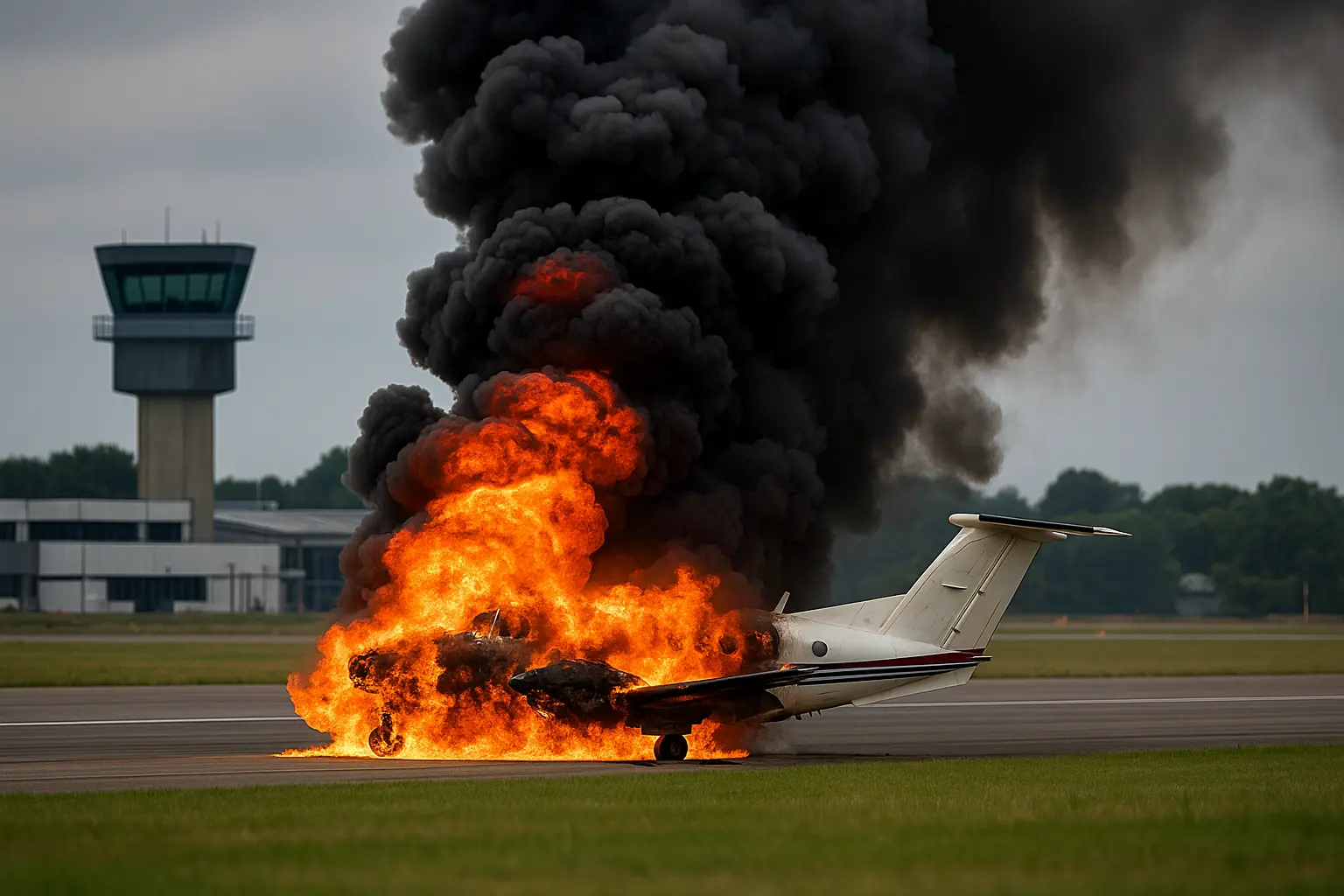A plane crashed at Southend Airport after takeoff. Get full updates, cause, aircraft details, and unseen facts in this trending UK air crash report.
Table of Contents
ToggleA Calm Flight Plan Turned into a Fireball — Here’s the Full Story Behind the London Plane Crash
On July 13, 2025, a twin-engine aircraft crashed just seconds after taking off from London Southend Airport, bursting into flames and sending thick black smoke into the sky. The aircraft, a Beechcraft Super King Air B200, was en route to the Netherlands but never made it far from the runway.
The shocking footage showing the plane spiraling and crashing into a field near the airport has flooded social media, leaving the public demanding answers. Here’s a complete breakdown of the incident, the aircraft involved, the rescue response, and the factors that might have led to this terrifying event.
What Happened at Southend Airport?
According to eyewitness accounts and initial flight data, the aircraft at Southend Airport took off normally but quickly encountered difficulties gaining altitude. Moments after liftoff, the plane abruptly banked sharply to the left, rapidly losing both speed and height before crashing near the airport boundary. The impact triggered a massive fireball, sending thick black smoke billowing into the sky, visible for miles around. Emergency responders arrived within minutes, but the flames had already completely engulfed the wreckage by the time they reached the scene. The cause of the crash remains under investigation.
What Kind of Aircraft Was Involved?
The plane involved in the crash was a Beechcraft Super King Air B200, a popular twin-turboprop aircraft used by charter companies for medical evacuations, VIP travel, and private flights.
Aircraft Details:
| Feature | Description |
|---|---|
| Model | Beechcraft Super King Air B200 |
| Engines | Twin Turboprop |
| Capacity | 6–9 Passengers |
| Speed | ~540 km/h |
| Use | Charter, Private, Medevac |
| Operator | Zeusch Aviation (Netherlands) |
| Tail Number | PH-ZAZ (unofficial reports) |
This specific aircraft was reportedly being used for a chartered medical transport mission to the Netherlands.
What Could Have Caused the Crash?
Though the full investigation by the UK’s Air Accidents Investigation Branch (AAIB) is ongoing, several early indicators point to possible causes:
1. Loss of Lift or Engine Power
Flight tracking data shows that the aircraft only reached an altitude of around 170–200 feet before rapidly descending. This suggests the engines may have lost power, or the aircraft didn’t generate enough lift — both serious technical failures.
2. Control System Failure
The Beechcraft B200 has had a history of trim or control surface issues in past global accidents. If the trim tab or rudder system malfunctioned, it could explain the spiral movement before impact.
3. Pilot Error or Fatigue
While the aircraft was operated by a licensed charter service, pilots in small aircraft often face tighter schedules and more fatigue than commercial airline crews. Human error due to pressure or miscommunication during takeoff could also have played a role.
4. Aircraft Age and Maintenance
Unofficial reports suggest the aircraft was built in the 1990s. While still airworthy, older aircraft are more prone to technical wear unless rigorously maintained.
Uncovered Details:
Most news reports have covered only surface-level updates. But here’s what no one is talking about:
The Tail Number History
PH-ZAZ has been flying for over two decades and was once used for air ambulance missions in Europe. Long service life can introduce structural fatigue if not rigorously maintained.
Pressure on Charter Pilots
Unlike commercial airlines, charter operators often work on tight schedules with fewer resources. It’s possible the pilot was under time constraints, or the aircraft wasn’t inspected as thoroughly between flights.
No Ground Collision Avoidance Tech
This type of aircraft doesn’t have advanced terrain awareness systems found in commercial jets. That means there are fewer systems to prevent low-altitude accidents.
Past Incidents with Similar Aircraft
Beechcraft B200s have been involved in multiple past accidents globally — including crashes in Australia (Essendon, 2017) and India (Delhi, 2015) — often involving control failures or overloading.
Official Sources-
Air Accidents Investigation Branch (AAIB)













